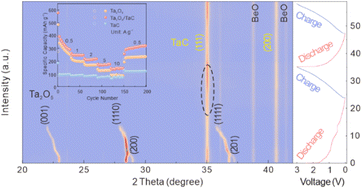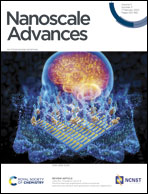Zero-strain strategy incorporating TaC with Ta2O5 to enhance its rate capacity for long-term lithium storage†
Abstract
Ta2O5 holds great potential for lithium storage due to its high theoretical capacity and long-life cycling. However, it still suffers from an unsatisfactory rate capability because of its low conductivity and significant volume expansion during the charging/discharging process. In this study, a zero-strain strategy was developed to composite Ta2O5 with zero-strain TaC as an anode for lithium-ion batteries (LIBs). The zero-strain TaC, featuring negligible lattice expansion, can alleviate the volume variation of Ta2O5 when cycling, thereby enhancing the rate capacity and long-term cycling stability of the whole electrode. Further, the formation of a heterostructure between Ta2O5 and TaC was confirmed, giving rise to an enhancement in the electrical conductivity and structural stability. As expected, this anode displayed a reversible specific capacity of 395.5 mA h g−1 at 0.5 A g−1 after 500 cycles. Even at an ultrahigh current density of 10 A g−1, the Ta2O5/TaC anode delivered a high capacity of 144 mA h g−1 and superior durability with a low-capacity decay rate of 0.08% per cycle after 1000 cycles. This zero-strain strategy provides a promising avenue for the rational design of anodes, sequentially contributing to the development of high-rate capacity and long cycling LIBs.



 Please wait while we load your content...
Please wait while we load your content...